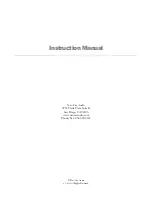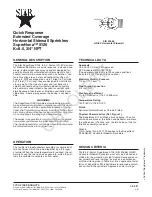
67
KP-812 Keypanels User Manual
keys for talking and listening. The default alpha names are N001, N002, etc. These
default alpha names can be changed to ones that are meaningful to keypanel opera-
tors using Port Alpha setup in AZedit.
For data routing purposes, port numbers are arranged in groups of eight sequential
intercom ports. In an ADAM or ADAM CS Intercom System, each Audio I/O card
comprises one data group. In a Zeus Intercom System, each group of eight port
connectors comprises a data group. Within each data group, each keypanel is
uniquely identified by is address setting. Whenever you display the Panel ID, the
intercom system determines which data group the keypanel is connected to, and also
the address setting. It then reports the calculated address. For example, suppose a
keypanel is connected to data group 3 and the keypanel address is set to 5. Since
each data group consists of eight sequential intercom ports, the calculated port
number for this keypanel will be (2*8) + 5, or 21. This is the total of all intercom port
numbers on the first two data groups, plus the offset of five ports into the third data
group.
RTS™ keypanels are calibrated to send and receive audio at the standard operating
levels of the intercom system. No audio gain adjustment is normally required when
connecting these. However, many other types of devices may not operate at the
standard intercom system levels. To assure signal level compatibility between the
various types of audio devices connected to the intercom system there are separate
analog input and output gain adjustments for each intercom port. It is also possible to
adjust the listen gain for any specific intercom port when listening to any other specific
intercom port. This is called the point-to-point listen gain, or crosspoint gain. For
example, a keypanel operator might want to monitor a music source connected at
some intercom port, but at a reduced audio level so that it does not interfere with
normal intercom communications. The crosspoint gain can be reduced for the
keypanel port listening to the port where the music source is connected. Analog gain
adjustment is only available using AZedit. Crosspoint gains can be adjusted either
within AZedit or from a programmable keypanel. For further information, see the
AZedit User Manual.
R
Relay
Relay is used interchangeably with GPI output. The relay feature works with the 16
GPI outputs of an optional UIO-256 Universal Input/Output Frame and with the relay
outputs of an FR9528 Relay Frame. The relay feature also works with the eight GPI
outputs of an ADAM, ADAM CS, or Zeus intercom system (J27 on a Zeus frame, J903
on an ADAM CS frame, and J11 on the XCP-ADAM-MC Master Controller Breakout
Panel in and ADAM Intercom System). You can assigned a keypanel key to control a
GPI output from any of these devices, and then use that key and output to control an
external device. For example, you could use a keypanel key to control lighting. Or
you could assign a relay as a level 2 talk key assignment in a stacked talk key ar-
rangement to both send audio and key a device, such as a paging amplifier or a 2-
way radio.
Summary of Contents for KP-812
Page 6: ...6 KP 812 Keypanels User Manual ...
Page 24: ...24 KP 812 Keypanels User Manual ...
Page 36: ...36 KP 812 Keypanels User Manual ...
Page 59: ...59 KP 812 Keypanels User Manual ...
Page 60: ...60 KP 812 Keypanels User Manual ...
Page 62: ...62 KP 812 Keypanels User Manual ...
Page 69: ...69 KP 812 Keypanels User Manual ...
Page 70: ......
Page 72: ...2 RVON 1 User Manual ...
Page 74: ...4 RVON 1 User Manual ...
Page 76: ...6 RVON 1 User Manual This Page Intentionally left blank ...
Page 105: ...RVON 1 User Manual 35 ...
Page 106: ......
















































